Customer Success is a relatively new function in SaaS and we talk a lot about it at SaaStr. While it’s only been around in it’s current iteration since 2010-ish, leaders have quickly realized Customer Success was is unequivocally integral part of a company’s growth.
Annie Tsai, Chief Customer Officer, knows a thing or two about what it takes to make customers happy and successful as this is her second turn as CCO. While she’s learned a lot of best practices, she’s also learned what not to do and wants to help you avoid the same mistakes she made.
Annie chats with Gadi Shamia, Chief Operating Officer at Talkdesk, about how to avoid listening to the wrong customers, using the right tools to help you drive customer success, and why it’s so important to treat success and support as two separate entities.
Check out the full transcript below! You can view Annie’s slides here.
If you want to see more sessions from 2016, we’re releasing a new one each week. Subscribe here to be notified. And be sure to grab your tickets to the 2017 Annual NOW.
TRANSCRIPT
Gadi Shamia: …Our last session is, surprise, about customer success too. Apparently, it’s a hot topic. You can sit here. We have a great speaker here. Annie is a Chief Customer Officer of DoubleDutch, which some of you are using here for the conference…You have a clicker. Some of using for the conference.
First thing is it we actually have Chief Customer Officers now, the pretty new title. I think it speaks the fact that customer success becomes more and more important part of making companies successful over the long run.
Annie, your presentation is really, really interesting because you’re talking about the mistakes you’ve made in customer success. I find it interesting because it’s such a new job. Ten years ago, no one has a title of Customer Success. People were doing support, or implementation, or any other job had to do with customer, but nobody had the title of customer success.
I think the job started solidifying in 2008, 2009, 2010 followed by some of the sales force customer for life program, so it’s a pretty new job, and most of the people run customer teams unlike you. You’ve been doing it before.
Doing it for the first time, or some of them for the second time, and there’s a lot of mistakes we are making. It’s a great time to talk about the ones we already made so that we don’t make them again.
Annie Tsai: Absolutely.
Gadi: So, with this.
Annie: Thank you. Hi everyone. Thanks for sticking around for the last session, Customer Success closing at SaaStr Annual, come on.
The reason why I was so excited to talk about the mistakes that you can make in customer success, and to a large extent, and a lot of the mistakes that I have made over the course of my career is because, just what Gadi said, it’s a new profession. 5, 10 years in, this is my second turn as a CCO. However, my background is primarily in marketing, marketing strategy and customer experience around that, and pivoted into the world of customer success almost by accident because it was the convergence of everything that I really loved about working for tech companies.
The five things that I’m going to talk about today are probably nothing new, that you’ve heard before, but I think it’s a really important reminder for us in the practice of customer success to step back and be reminded of these probably pretty simplistic things for you, and I’ll go into a little bit of detail.
Also, I have an ask for you, since this is the last session at SaaStr Annual, if you all could, if you are on the app, pull out your app, post things to the activity feed. I want the folks at the happy hour seeing about customer success content, hearing the sound bites, going home, sitting on the plane, looking back at the activity feed, and seeing that we were still talking about customer success.
If you guys would do that for me, that would be great.
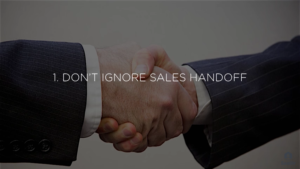 Number one, don’t ignore sales handoff. Sounds pretty obvious, but let’s talk about why it’s really important to not ignore sales handoff. Because the buyer’s journey cuts off pretty dramatically if you do.
Number one, don’t ignore sales handoff. Sounds pretty obvious, but let’s talk about why it’s really important to not ignore sales handoff. Because the buyer’s journey cuts off pretty dramatically if you do.
If the handoff between buy and onboard, especially if you’re an enterprise SaaS provider, is truncated by a difficult conversation or by the customer having to repeat themselves three or four times about why they chose you as a vendor, then that makes it even harder for you to get to the use case of them becoming loyalists, and eventually to the thing that is the golden land for all of us, which is “buy more.”
An expansion during the first year contract is everything that we’re striving for in delivering expansion worthy experiences. However, if you never get to a great sales handoff, then it’s going to be extremely difficult for you to get to expansion.
Now, why is it important, and what are some of the things that you want to know around the crossover from buy to onboard? Well, one of them is you really need to know where they’re coming from, why they decided to buy?
You really shouldn’t have to find out directly from them. You shouldn’t have to ask them, because the sales rep has already determined that during the sales cycle, and they’ve probably already given them a value statement that got them to close.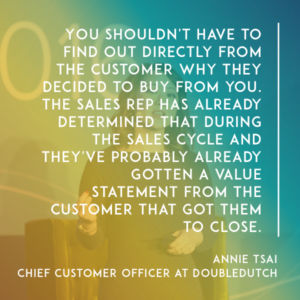
I’ll give you an example of DoubleDutch. DoubleDutch has quite a few reasons to buy. This is why it’s so critical to understand why that specific buyer chose to buy. For us, for instance, event organizers are buying mobile event apps or digital experiences, for a myriad of reasons.
They could be buying because they want to spend less money, they don’t want to print paper agendas anymore. They could also be buying because they want to monetize, exhibit, or spend. They could be buying because they want to be considered thought leaders in their space.
Depending on where they start, the customer success person on that account should be telling them a very different story. But we need to know at the point of sale why it was that they chose our offering over someone else or at all.
The second thing that’s really important is you really want to know how did they get here, what was the journey that that buyer went on, in terms of their digital and offline footprint.
I really like Roger Lee. He’s from Battery Ventures. He wrote this great article mid last year about the MSG stack, which is the Marketo, Salesforce, Gainsight stack. Really, that’s the MSG stack that we use at DoubleDutch as well and that’s where all of our data lives. That’s our database of records for customer activity for both the digital and in offline footprint characterization.
What are the things that we can learn from this data stack to help us deliver a better personalized experience? There’s a lot. We know, for instance, how long someone has spent on a product page. Maybe they bought one product but spent a lot of time on another product page. There’s value that we could be drawing from that.
We also know what videos they watched when they dropped off. We know if they had downloaded specific gated access downloads, once, twice, multiple times. If they decided to give us more information for a specific piece of content than another piece of content, we get all of that.
We also know if they perhaps decided to buy something in the past or if there was a specific scope of a prior conversation that was recorded in Salesforce. All of that data is coming together in a single place. We should be using that in the role of customer success to deliver that personalized experience. The more we are able to leverage that information it’s all there, the more we’re able to get to expansion and renew faster.
What does that get us? All of that data gets us the ability to really deliver on those memorable moments. It’s reinforcing the why, why did I buy, the why that they never had to tell us because we already knew at the time of purchase.
This is one example from a customer that was having an internal conference. One of the goals for why they bought was because they really liked that we could gamify the experience and create a level playing field, an open conversation between the executives and the rest of the employees.
This picture is of the president taking a screenshot of The Leaderboard and posting to everybody and asking them when we can pick up his prize. It created an experience where everybody could just have an open dialogue and competition was OK. That was their why. We could deliver that for them and we could tell them why but we knew that going in so we could build an experience against that.
The second why would be…This is from a SaaStr Annual post a few weeks ago before anybody ever got to San Francisco. I wish I’d have the company have things for letting me use this image, by the way. He posted that there was a validation for why Lemkin even puts these events on in the first place, why 5,000 of us SaaS professionals are coming together to learn more. This is the validation.
Last year, it helped me solve my biggest challenge, which is finalize my product and get to market. That’s the why for Lemkin and his team. We are able to deliver that against that why. We were able to identify that also because we have that information in Salesforce and in Marketo going into the conversation for when we were going to kick off our project.
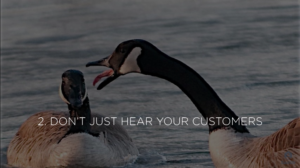 Number two, this is a message around hear versus listen. I’m going to make an assumption that a lot of people in this room do customer satisfaction surveys and we listen to our customers, we get inputs from our customers. Who sends out an NPS survey? Raise your hand. A lot of people? OK.
Number two, this is a message around hear versus listen. I’m going to make an assumption that a lot of people in this room do customer satisfaction surveys and we listen to our customers, we get inputs from our customers. Who sends out an NPS survey? Raise your hand. A lot of people? OK.
A really important thing about when you’re asking a customer for feedback is to really take the context behind the number, that NPS number. I’m going to show you two examples of some NPS responses that we’ve gotten over the last six months, I believe. This one’s a 10.
The question that I always read with every response is, “What is the one thing that we could do better?” This was some feedback on how we do our one to one direct communications. This customer became a beta test candidate. The timing for their feedback was perfect because we then brought him and made him feel like an advocate. Also, he was able to become an early tester of our software.
The second one is a 9 NPS. Their feedback was around folks really needing easier access to more help on downloading and using the app and things like that.
The message we took around that was, even though we’ve done five iterations maybe of how we do this onboarding experience or how we do access to help, we need to continue to iterate because our customers are never going to be a hundred percent adopting as easily as we think they are. Those words we wouldn’t have gotten if we had just taken the number for granted.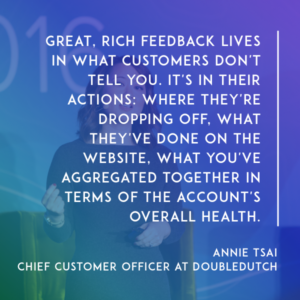
It wouldn’t be a PowerPoint presentation without a picture of an iceberg. There is a place where there’s just great, rich feedback, and that feedback lives in what they don’t tell you. It’s in their actions, where they’re dropping off, what they’ve done on the website, what you’ve aggregated together in terms of the account’s overall health.
That’s really where you’re going to get the meatiest context for where you can establish your customer’s success practice. I’ll give you an example. In some of the product drop off for a feature that we had launched that had gone into Beta. We didn’t understand why this one thing was happening.
What we started doing is we started to look at the click rates. We found that it took 10 clicks to do this one action. Obviously, if it takes two minutes to figure out how to do something, they’re just not going to do it. So that got reduced to three clicks, and then we saw an increase in completion rates there.
All of that is a part of customer success. Yes, that lives with the product organization. But the feedback loops, the inbound feedback loops, are going to be coming from you guys. It’s going to be come from the customer success leaders that are talking to customers and reading their report data and seeing which customers are being successful and which are not.
What’s the risk of listening and then ignoring the feedback? It’s really right here, which is if you only just listen and then you do nothing with that, then you miss out on the opportunity to do the most important thing, which is acknowledge the person that is giving you that feedback.
99 percent of the time I would think, at least based on my personal biases or personal experience, is that all they really want is to feel heard and for you to say thanks. “Thanks for taking the time to tell me that you cared enough to give me that feedback.”
Now, there’s going to be a spectrum. There’s going to be the one side of the advocates and the key promoters that are giving you that feedback because they love you so much, they just want you to be so much more better. Then there’s the other end of the spectrum, which is they have become detractors due to the experience.
Those people are the people that you need to put in a room together and engage. Include them in product usability sessions, because then you have an opportunity to bring those detractors up. You have an opportunity to give your promoters a platform to talk about how much they love you and why they love your product.
Then, the last piece about it that you really miss out is you really miss out on the chance to celebrate and announce the integration of the customer voice into your program and into your product development road map.
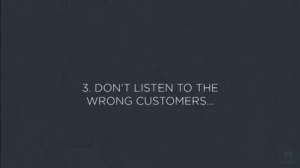 This third one was really interesting because it was suggested by my VP of products. Dan spoke about this a little bit. There is also a big mistake that we can make around listening to the wrong customers. I really like going back to Paul Graham who is one of the co-founders of YC. He created “The road map of startup.”
This third one was really interesting because it was suggested by my VP of products. Dan spoke about this a little bit. There is also a big mistake that we can make around listening to the wrong customers. I really like going back to Paul Graham who is one of the co-founders of YC. He created “The road map of startup.”
Most of us, I would assume, live in this space. Which is you’re just past that point in a startup where you got the great idea and you’re starting to realize, “Oh, man. This is really hard.” People aren’t thinking about it in the same way that I’m thinking about it.
Then, all the way through the Trough of Sorrow , all the way through, “I think I have product road map fit. Wait. No, I don’t,” or “product market fit. No, I don’t.” Then you’re starting to see acceleration. How many people are in that period where you got the great idea, you’re trying to figure it out to, “I think I got product market fit.”?
I would assume at least half of the people at SaaStr based on who I’ve talked to.
Gadi: Let’s just start. Ask them again.
Annie: How many people are in that space? Raise your hand.
Gadi: You’re right. 50 percent.
Annie: I think we’re probably right, trying to get out of that space, too. That’s probably the most fun part of the startup life is once you just think you got it, right? But when you are in that area, you have to be extra cautious about who you listen to, because if you listen to someone who is outside of your core, then you run the risk of going too wide. You run the risk of veering off track.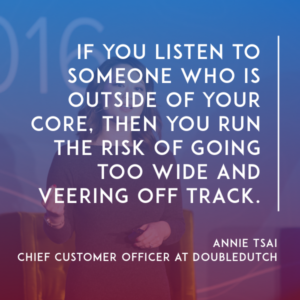
I created a little decision tree for the team since we’re in the tactical theater, which is asking yourself the question of, “Is this person or this use case that I’m getting feedback on in the core market that I’m going after?”
If the answer to that question is, yes, then the very next question you’re asking is, “What does this person know about my customer who I’m going after that I don’t know?” Because they probably know a lot that you don’t know, so bring them in and include them. Then, of course, make sure that the insights go to the right people. A much larger company calls this the VOC type program.
If the answer is no, then the very next question is, “Should we be in that market? Is that a market that we should be going after?” That’s where you’re challenging yourself, your co-founder, and your peers as to whether or not the core that you’ve selected is actually the right core?
If yes, you go back to that next question. What does this person know that I don’t about the people that I’m going after? If no, there’s another question after that, which is, “Is that use case common enough or relevant to my core market that I need to consider it?”
That actually happens more often than not, because something that happens in financial services, for instance, you may discount because it’s a financial services customer, but the relevancy may be very, very relevant for Pharma or education. So, definitely ask yourself that question. It goes back to, “What does this person know that I don’t?”
If the answer to those three questions is no, “Thank you. Move on.” Maybe you’re a good churn or maybe, “It’s great that you can use us for what you need us for, but we’re not going to take that feedback and build against it.” That’s OK too, because you’re not going to get a hundred percent hit on your customers when you’re just trying to get to product market fit.
Gadi: This is an interesting point. How do you reconcile between two and three? Point two is, don’t ignore the feedback, but for this specific customer, you just ignored the feedback. I totally agree to the concept, but how do you explain to the customer in a way that doesn’t turn them into a detractor?
Annie: It’s a great question. It really goes back to how you acknowledge. There are a lot of customers that give us incredible feedback all day long, but it’s not something we’re going to be building out right away. Or maybe it’s not within our core market as we define it today.
But what we always try to do is we try to keep a dialogue going and make them feel heard, let them listen. I have on many occasions told people at this job, my prior job, and the job before that, “That’s a really great idea. It’s not a use case that we are thinking about implementing right now, and this is why.” If that’s OK then we just move on.
Gadi: My advice, by the way, here would be, don’t be afraid of having customers taking you to new territories. Our customers, for example, took us, Talkdesk, to the SDR use case. By the way, I think DoubleDutch is the customer using us in the SDR space as well.
Initially, this feedback was not in the core offering we had, but enough people gave us the same feedback that drove us to start changing to, or making us part of a core offering, so customer success is one of the best places, and so heeding the feedback already on because sometimes you sell the product this way, and all of a sudden people use it in different way, and sometimes worth following.
Annie: Absolutely. That question of should we be in that market? The customer success department or team is going to be, I mean, I would argue the best place for you to be answering that question because you get all of the use cases. You understand when it’s working well. You understand when it’s not working well and why, and you can aggregate all of that information and tell such a rich story about what’s working and what’s not and why to the other people in your team.
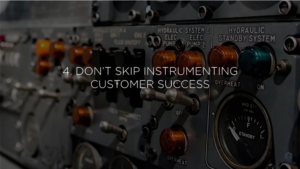 Instrumenting customer success is tremendously important, and I’ll tell you why. Because five years ago, even six years ago when customer success roles were first getting started, we didn’t have great software to help us machine learn which accounts we should spend our time focusing on. We had a telephone and that’s minimum viable tooling.
Instrumenting customer success is tremendously important, and I’ll tell you why. Because five years ago, even six years ago when customer success roles were first getting started, we didn’t have great software to help us machine learn which accounts we should spend our time focusing on. We had a telephone and that’s minimum viable tooling.
Most startups when they start up, they just pick up the phone, or they use their email, and they use their gut to try understand who they should be spending their time on and who would be the most valuable customers for expansion. So when I think about kickass tooling, really what I think about is understanding across my customer base, across my renewal opportunity by month. I need to be able to red, yellow, green all of the revenue. I need to know who’s at risk.
I need to know why. I need to know what’s going on with them. I need to know what the characteristics of that risk are, and this is what we use today and this is not an ad for Gainsight, but this is one of our screenshots from our Gainsight instance. How do we do that? What was the process that we went through to do that? The first thing that we did was we sat down and we audited and created a definition of what a successful customer looked like. What does ROI look like?
We define that in terms of RYG, so every three weeks, we get together, the customer success leadership team, and we audit every event that DoubleDutch is powering, and we give them a red, a yellow, or a green, and we say, “Why?” And those are standardized whys and we measure ourselves against that. At any given moment, we have less than a percent of reds, and we clearly are able to organize our product organization and our engineering team around the why and the reds.
Next, is taking that definition, and then defining the subjective inputs, and the processes that you need to capture the additional stuff. Like for instance, what are the gaps in the data? What don’t you have? Does it take automating some process in order to get that data which might be a little hard for a small company but might be worth it in the long run, or does it mean that you need to add a field in Salesforce to capture something additional, could be as easy as that.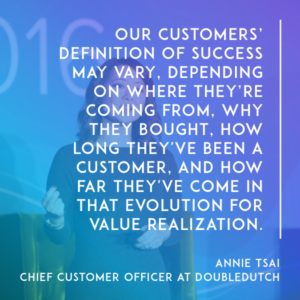
Then, the next step was identifying data that validates client success, and so we have a definition of success but our customers definition of success may be different, and it goes back to the from too, which is depending on where they are coming from, why they bought, how long they’ve been a customer, how far they’ve come in that evolution for value realization.
That definition that the client uses for success is going to be really important, and so creating the standards around understanding how our clients will delineate success is going to be important too. Identifying the missing data. There’s going to be a lot of missing data probably. Continuously, you’ll be finding out that you are missing stuff that you probably should have known, and deciding how to get it, and then getting out there and doing it.
Connecting the data sets is actually a lot harder than it sounds. If you are on the MSG stack, the Marketo, Salesforce, and Gainsight, it’s actually pretty easy, but a lot of people have home grown systems like our clients, and so we spend some time integrating with them and pulling their data in.
The last piece, of course, most important for our customer success practice is driving adoption. Getting our clients in there using it, depending on the offering from a day to day basis around the most critical questions that they are asking, making sure that the data that we give back to them is data that they use in their executive meetings to talk about ROI. Those are the things that drive practice adoption for us and perhaps for you as well.
Gadi: Quick comment as you switch to your next slide and your last topic. I would add a couple of advices. One is, don’t tool too quickly at this level because you need to understand what are the drivers of growth, and what are the drivers of success. For a product like Asana which is more of a, you can use it, or you don’t use it. Usage, expansion within organizations is really important, but there are other tools that don’t react this way.
The first thing is understand the qualitative value of what drives growth, what drives churn, and what drives success before you tool the wrong things because even a great product like Gainsight, is not a one product fits all. You need to customize and tool it the right way. Spend some time understanding what drives customer success before you try to tool it because you might get the right tool like Gainsight or Totango any of the other tools, but you might tool it wrong, and the tool become useless for you or might tweak it wrong.
Annie: Absolutely. I couldn’t agree more. The definition of how you define success, how a client defines success, and also how that potentially changes as you start building in your use cases is continually checking and rechecking that is critically important, totally agree.
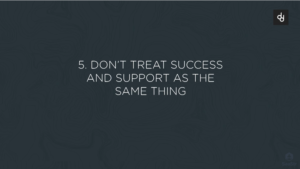 The last thing, and a lot of startups fall into this, which is treating support and success as the same thing. I’m sure if you have a 30 person or smaller team, you are in this bucket. Maybe bigger even. I’ve seen bigger.
The last thing, and a lot of startups fall into this, which is treating support and success as the same thing. I’m sure if you have a 30 person or smaller team, you are in this bucket. Maybe bigger even. I’ve seen bigger.
How you know you are in that world is after the sale, especially in the enterprise, your success person is getting on the phone and they are saying, “Hi, I’m Annie. I’m here to do whatever it takes to make you to love us.” Do people do that? I think in the startup world, that happens quite a lot. Over time, it’s splits out. It spits into an onboarding experience.
You need to start thinking about onboarding, and then you start thinking about what do we have to do to be proactive about driving value realization, and then there is this piece about reactiveness. What are the things that are happening that shouldn’t be happening that we’re really reacting to after the fact and the customer’s coming to us and asking for help for it? How do you know that you need to make a split between success and support?
Depends on where you start. I’ve had this conversation with several customer success practitioners that are doing it all right now. I think the big message is, it doesn’t matter where you start because where you start is going to depend on the need that your company has at the time, and it is also going to depend on who your customers are, how complex your product is, and how long it takes to onboard, and all of those things, so where you start is your decision.
However, once you get there, there are some key triggers that you should know for understanding when it’s time to break out. Let’s assume you start with support or customer care. You are going to find at some point, customers are going to start asking about the best way to do something. They don’t want to know what or how. They want to know the best way to do something because maybe there are more ways to do it than just one.
You are also going to be asking like, “Is there someone who’s held accountable for renewal?” If there’s not, if the sales reps are scrambling to grow new business, and potentially also renew existing SaaS contracts, there is an opportunity there that’s not being captured. These two go together which is, are the questions that are coming in, the why and the when questions, are those increasing over time? You are also finding that the what and the how questions are decreasing or even staying flat over time.
If you are finding that shift, if you are feeling that shift, it’s probably time for you to think about customer success and that value story, someone driving value a little bit differently than you have been in the past. If you start with customer success, the first question you are going to be asking is, is my work getting more reactive over time?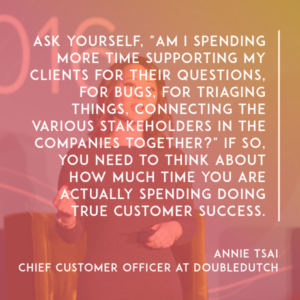
Am I spending more time supporting my clients for questions that they are asking, for bugs, for triaging things, connecting the various stakeholders in the companies together, and if so then, you need to think about how much time you are actually spending doing true customer success. Am I able to deliver meaningful renewal and expansion targets for the company or influence meaningful renewal and expansion targets for the company?
The reason why this is so important is because in a SaaS business, typically, the first deal that’s sold especially in the enterprise is not that big. Like you are proving yourself, especially if you are a smaller startup or in a new market, so if you are not able to land and expand those deals, then you need to think about what it is that you are actually doing and whether or not you should be doing those things.
Of course, these two go together too which is are the why and the when questions decreasing, and so those best practice types of questions are more of people asking you what and how, and if so, then the split probably needs to come sooner than later, so your customer success team can think about driving value and thinking about expansion worthy experiences. Hey, those are the five. We blew through it…
Gadi: Excellent.
Annie: I think we have a few minutes.
Gadi: Yeah. That was great. On the last point by the way with one viewpoint, at Talkdesk, we added the customer success team about eight months after we created the sales team. I think it’s a good timing for that. You add in the first sales professional on salesperson. You get on the annual contract. You want to have customer success because most of you have support before customer success. You want to have customer success in place before the first renewal.
We have three distinct teams that we did pretty early. Implementation, and we drive them over time to be break even or profitable. They are not either place right now, but this is their long term goal. We have customer support which is 100 percent reactive that 24 by 7. They will be there when you need them, and we have customer success build the long term relationship and build this friendship and connection between the company and the customer.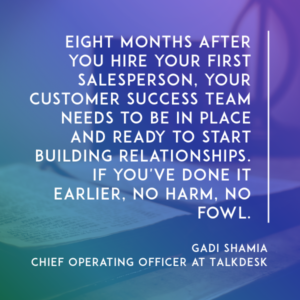
The real job is turn the customer into a stakeholder in a company, which support cannot do because it is reactive, and implementation cannot do because it is short term. So I will do it eight months. This is I think it’s the magic number. Eight months after you hire the first sales person, your customer success team needs to be hired and be in place. Ready to start build this relationship, and if you’ve done it earlier, no harm, no fowl. With that, was great presentation.
We’ll take few questions because the only thing between us and the end of the day is the happy hour, I guess.
Male Participant: I’ll make it quick. For the timing, when you are hiring a customer success rep, what is the persona profile they should be looking in that person because if you get the wrong one, it could be a mistake as well?
Annie: That’s a great question. There are a couple of characteristics that I always hire for that are more tied to culture fit, but specific to customer success professionals. I think it’s super critical that you find someone that has an intensely curious mindset. They are really, really interested in what the customer is looking for, the problems that the customer is trying to solve, they’re really relationship driven, and their primary focus is that person that’s right in front of them, right now. Of course, that changes over time as you start to scale your organization, but that’s the personality that you look for.
For us at DoubleDutch we also look for folks that are on the more technical side because our offering can be more technical and our customers are less technical, so folks that, kind of, have a sales engineering, consultant type of personality that can really be a connector between third party vendors, as our engineering integrations folks, and event marketers. So it really depends also on the need of your customer.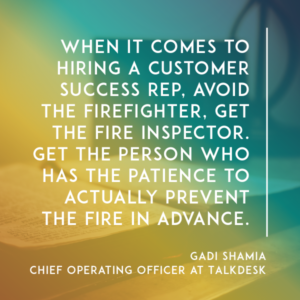
Gadi Shamia: I’ll give you a Tweet length answer. Avoid the fire fighter, get the fire inspector. Don’t get the energy of the fire fighter, “Yeah, we go and organize the chaos.” Get the person who have the patience to actually prevent the fire in advance.
Male Participant: Hiring from customer is OK?
Gadi: Sorry?
Male Participant: Hiring from the customers is…
Annie: We have done that, yes.
Gadi: Our director of customer support is a previous customer. It’s a pretty great success for us.
Annie: Mm hmm. Hi.
Female Participant: Thank you very much for sharing all the insights. In the cycle from sales implementation through the life cycle of a product, when is the optimum time to introduce the CSM to the team, to the customer team?
Annie: We’ve actually been playing with that quite a bit at DoubleDutch, and we’ve moved that introduction earlier in the life cycle, especially on our larger accounts, on our more enterprise deals, to just before the deal is closed, as a part of a strategic pitch for the post sale experience and what to expect. In our scaled business that still happens after the deal is signed, but it’s very, very shortly after.
Gadi: And avoid all costs doing it after the implementation, which some large SaaS companies do and then you cannot prevent catastrophes if they happen during the implementation before you go live.
Female Participant: What is your onboarding and training process like for customer success reps, and for those who don’t have a technical background for software, versus the ones who do?
Annie: Our training program has also gone through quite an evolution, but I’ll tell you about the objectives that we strive for. There is the company culture part of it, which I think a lot of companies really focus on the first couple of days, and then we really dive into product knowledge, and we really just, kind of, put them on the front lines and have them really engage, and do a ton of shadowing.
Because, in our world, every event is a little bit different, the objectives of the event and how they’re going to utilize our software is going to be a little bit different, exposing them to as many use cases as possible is going to be critically important.
We will team them up with a peer mentor, and they’ll work on projects with them actively, and really get into meaty work pretty early on. Then they start owning more simplistic stuff, and accounts, and once they start getting quick wins underneath them then they go. It’s not a super formal process, and I think that we’re still probably pretty early days in our training program. I don’t know, Gadi, if you have any other feedback to give there.
Gadi: No, late.
Annie: [laughs]
Gadi: Rapid fire question.
Annie: Yep.
Gadi: Last one.
Male Participant: Thank you for your talk. This was great to hear. So let’s say we hear all this feedback from our customers. We listen to it. We improve what we do for them and it works great for 95 percent of them. Five percent of them are no longer going to be a fit for us and we don’t want to try and continue to work with them if it’s not going to serve them well. What is best practices about firing customers proactively?
Gadi: Oh, the best question saved for last.
Male Participant: You know you have to do it.
Gadi: Oh, it’s a great question. It’s a great question.
Annie: Yeah, I will be honest and say that I’ve only fired a customer once. The way that I did it was really just offering that they were welcome to continue to use our solution knowing that there would be this gap in what they were looking for. If they were OK with that then they can continue to do that, and if not then I suggested another provider for them.
Male Participant: Thank you.
Annie: Sure.
Gadi: I had to fire a customer once, and I kid you not, after he locked me in a basement of his office, twenty years ago, and didn’t let me go out, so this, I think, was a cause for termination.
Gadi: I did break out eventually but he’d locked me in a basement until his problem is solved. This was in the…before SaaS, so we had to actually go and fix the product, burn a CD, and bring it back, yet he was still wouldn’t let me go out of his office. So this was a cause.
Annie: It’s like a movie.
Gadi: Never happened to me, ever since twenty years ago. Annie, it was fantastic. Thank you so much.
Annie: Thank you.
Gadi: And guys, thank you so much for staying until the end of the event.
You can view Annie’s slides here.
